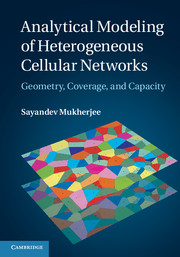Book contents
- Frontmatter
- Contents
- Preface
- Acknowledgemants
- List of notation
- List of acronyms and abbreviations
- 1 Introduction
- 2 Structure of the SINR calculation problem
- 3 Poisson point processes
- 4 SINR analysis for a single tier with fixed power
- 5 SINR analysis for multiple tiers with fixed powers
- 6 SINR analysis with power control
- 7 Spectral and energy efficiency analysis
- 8 Closing thoughts: future heterogeneous networks
- Appendix A Some common probability distributions
- Appendix B HCNs in LTE
- References
- Author index
- Subject index
8 - Closing thoughts: future heterogeneous networks
Published online by Cambridge University Press: 18 December 2013
- Frontmatter
- Contents
- Preface
- Acknowledgemants
- List of notation
- List of acronyms and abbreviations
- 1 Introduction
- 2 Structure of the SINR calculation problem
- 3 Poisson point processes
- 4 SINR analysis for a single tier with fixed power
- 5 SINR analysis for multiple tiers with fixed powers
- 6 SINR analysis with power control
- 7 Spectral and energy efficiency analysis
- 8 Closing thoughts: future heterogeneous networks
- Appendix A Some common probability distributions
- Appendix B HCNs in LTE
- References
- Author index
- Subject index
Summary
Introduction
We have already discussed why the wireless cellular networks of the future are going to be heterogeneous in nature, with a mix of BSs with different capabilities and characteristics. The spectral efficiency advantages obtained by dense spatial reuse of resources are driving the deployment of small-cell (i.e. small in terms of range or cell size relative to macrocells) tiers as overlays on the existing macrocellular tier.
It is interesting to observe that, as cell sizes shrink, they become comparable to the range of WiFi (IEEE 802.11) access points. This has led to a resurgence of interest in the peer-to-peer (P2P) mode of operation of WiFi, now enhanced and extended to cellular links as device-to-device (D2D) communication, as a means of further enhancing area-wide spectral efficiency. Thus, future heterogeneous wireless networks are also expected to support such D2D communication. As a result, the wireless cellular networks of the future will be not only heterogeneous, but also not even fully cellular – direct transmissions between user devices will be not only permitted, but also enabled by the BSs in order to support ever greater numbers of simultaneously active links within each cell.
Analysis of a network with D2D links
With the renewal of interest in D2D links, it can be said that the analysis of wireless networks has now come full circle, back to its original roots in P2P links (Hunter et al., 2008; Weber & Andrews, 2012). However, a wireless cellular network permitting D2D transmissions among user devices exhibits some novel features not seen before.
- Type
- Chapter
- Information
- Analytical Modeling of Heterogeneous Cellular NetworksGeometry, Coverage, and Capacity, pp. 154 - 158Publisher: Cambridge University PressPrint publication year: 2014



